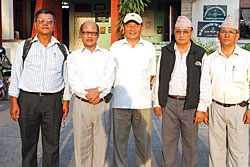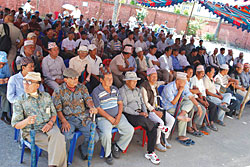 STAYING HOME: (r-l) Gajendra Ispo, Nar Bahadur Thapa, Bhaktesar Rai, Ram Naryan Kandangwa are a handful of former Gurkha soldiers who have decided not to emigrate to the UK. |
Recently the houses have gradually been emptying, the gardens neglected as more than half the 10,000 ex-Gurkha families in Dharan migrate and settle in the UK.
But Ispo says he is not for settling in the UK, "I want to live a life of dignity in my own country. In the UK, I will be degraded to a second grade citizen. Why go to a foreign country to slave for others? My principles don't allow that."
Since the Gurkha Army Ex-Servicemen's Organisation (GAESO) was set up, Ipso has been actively involved in the fight for equal treatment of the Gurkha soldiers. He has been trying to help the families of the remaining ex-Gurkhas in Dharan. But as most Gurkhas have left to settle in the UK, he says he has not been able to help as much as he would have liked to.
Supporting Ipso is Ram Narayan Kandagwa, who has also decided to stay back. After his pension arrived, he completed his PhD on Nepali British relations with special focus on Gurkhas. Kandagwa explains, "I am against going to the UK because I believe that we have to make a contribution to Nepali society. British society, culture, religion and lifestyle are different. Language is a problem as well. In addition, our life will be of a lower standard. My life here is good, why should I leave? There is no point." Along with Ipso and Kandagwa other Dharan residents who have opted to stay include Ramesh Rai, Nara Bahadur Thapa and Bhaktesar Rai.
But there are very few who choose not to join the race. According to GAESO there are about 40,000 ex-Gurkhas, the majority of whom have chosen to migrate with their families, which totals 60,000 Nepali people. Towns like Dharan, Damak, Pokhara, Butwal, Itahari and Palpa, which used to have heavy settlements of ex-Gurkhas, are now almost deserted. Many families sold their houses and property before leaving.
 PICS: SITA MANDEBA Former Gurkha soldiers gather at a mass meeting earlier this year (left) |
The Ex-Gurkha Organisation, women's committee used to have 300 general members and was very active in social service activities in Dharan. Now they rarely have enough women to justify holding a meeting. Local businessmen say the mass emigration has had a detrimental impact on local businesses. Remittances have also gone down.
But the situation has not discouraged the ex-Gurkha community. Despite the low manpower, they are determined to carve out an identity for themselves and perpetuate the ongoing works. Those who have left also contributed to the projects.
The Gurkhas united in 1995 to fight against the injustice of inequality. They had put forward a four-point demand of which three have been granted. The soldiers who fought in World War II received compensation of 10,000 pounds each in 2002. Gurkhas recruited after 1997, were granted a permanent residence visa in 2003. Then, another ruling in favour of the Gurkhas earlier this month granted permanent residency to soldiers who had been in service for more than four years. Permanent residency was not a part of the four-point demand. Their main demand, which is for Gurkha soldiers to receive a pension equal to that of their British counterparts, is yet to be fulfilled.
The UK started recruiting Nepali soldiers after the 1816 Sugauli Treaty. There are now 35,000 Nepalis in the British army. Every year more than 200 Nepali youths are recruited.


